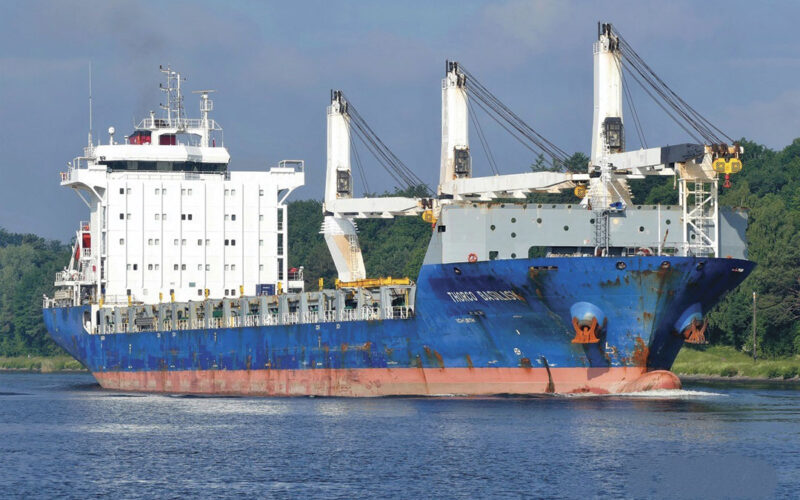
Federal investigators believe undetected deterioration caused a crane wire failure during the offloading of a 76-ton wind turbine nacelle from the 530-foot Thorco Basilsik at the Port of Houston on July 23, 2022.

The 1.5-inch-diameter rope consisted of 37 strands with seven wires per strand surrounding a plastic-coated core.
The Swiss-flagged heavy lift vessel arrived at Dock 4 at the Greens Port Industrial Terminal the day before with a cargo of 11 wind turbine nacelles, turbine components, and a number of containers.
The 11-year-old, 528-foot ship has three cargo holds, with No. 1 toward the bow, No. 2 roughly amidships and No. 3 furthest aft. Each hold has a dedicated MacGregor GL crane rated for an 88-ton safe working load mounted on the vessel’s port side.
The wind turbine cargo was loaded on the ‘tween decks on the Nos. 1 and 3 holds.
The ship’s crew was not actively involved in the handling of the cargo. Stevedores boarded the ship at about 6:45 am on July 23 as BBC Chartering, Thorco Basilisk’s charterer, had elected to use the vessel’s onboard cranes to offload rather than incurring a fee by using shoreside equipment.
Cargo operations began at about 7:15 am following a job safety analysis and a visual inspection of the No. 3 crane. That hold was fully unloaded within three hours, and at about noon crews began lifting cargo from No. 1 hold – the first time in several months the No. 1 crane had been used for a heavy lift.
According to the recently released National Transportation Safety Board (NTSB) report, at 12:30 pm, “the stevedores used crane No. 1 to begin off-loading three nacelle units from the cargo hold No. 1 tween deck,” the report said. “They removed two of the nacelle units without incident and rigged a third nacelle with slings and shackles in preparation for resuming work after breaking for lunch at [1:00 pm].”
Operations resumed about 90 minutes later with the same stevedores using the No. 1 crane. The team held another job safety analysis and a visual check of the lifting gear before resuming work. The crane raised the turbine nacelle about six feet off the deck when the wire snapped and the nacelle crashed down into the ‘tween deck near the stevedore crew, none of whom were injured.
The MacGregor cranes use 1.5-inch-diameter Verope wire rope, which consists of 37 strands with seven wires per strand surrounding a plastic-coated core. Testing showed the rope could lift up to 154 tons before parting.
The wire rope itself was manufactured 14 years previously and had been in use for nine years, one year short of the 10-year maximum allowed by DNV-GL, the vessel’s class society. However, following the incident, Thorco Basilisk’s management company changed the crane wire replacement period to every five years, the NTSB said.
During the investigation, the agency ruled out several potential causes including a sudden motion or “shock load” on the line as the cause of the wire rope failure. Investigators also found that the crane’s rigging equipment remained intact after the wire rope parted.
Corrosion and wear, the report said, “caused some of the individual wires comprising the strands of the hoisting wire rope to part when crane No. 1 lifted the nacelle unit, subsequently causing the strand and then the remaining wire strands to become overloaded and fail,” according to the NTSB report.
Surveyors and crewmembers aboard the ship did not recognize the corrosion on the wire rope before the incident, as visible signs of corrosion were not evident until lubricating grease was removed from the wire.
However, that step was not required as part of regular maintenance despite a recommendation by the manufacturer. “Without removing the grease to examine the wire rope, the corrosion on the wire rope could not be detected,” the NTSB report concluded.
Damage to the ship and the nacelle unit reached a combined $5 million and cargo operations ceased following the incident. Two days later, stevedores successfully offloaded the remaining cargo using a shoreside crane, and Thorco Basilisk departed Houston for its next port of call.
The U.S. Coast Guard later issued a safety alert to ship owners and managers following the crane wire failure aboard Thorco Basilsik.
The alert recommended vessels equipped with shipboard cranes implement load tests more frequently than the five years required by class societies.
The alert also suggested replacing wire rope earlier to prevent corrosion “and fatigue induced failures,” ensuring crew are trained in industry best practices and how to conduct appropriate visual inspections of crane wire rope and instructing personnel to remove grease from crane wire rope before conducting inspections.

